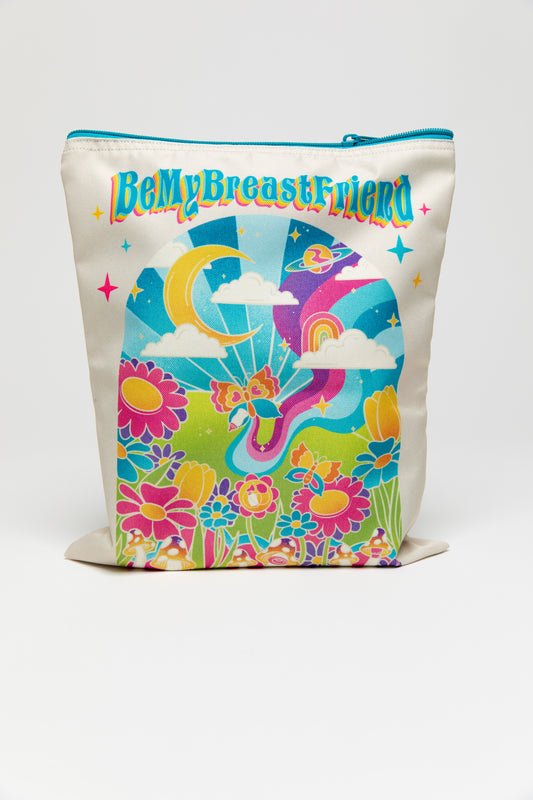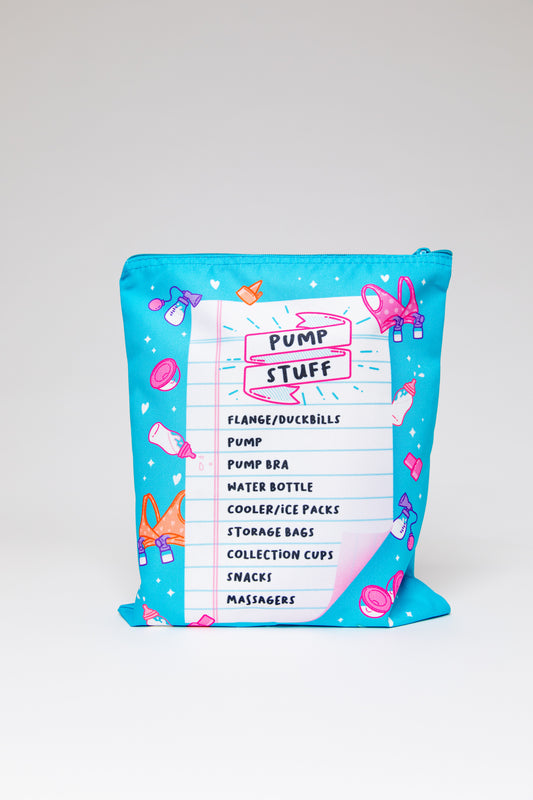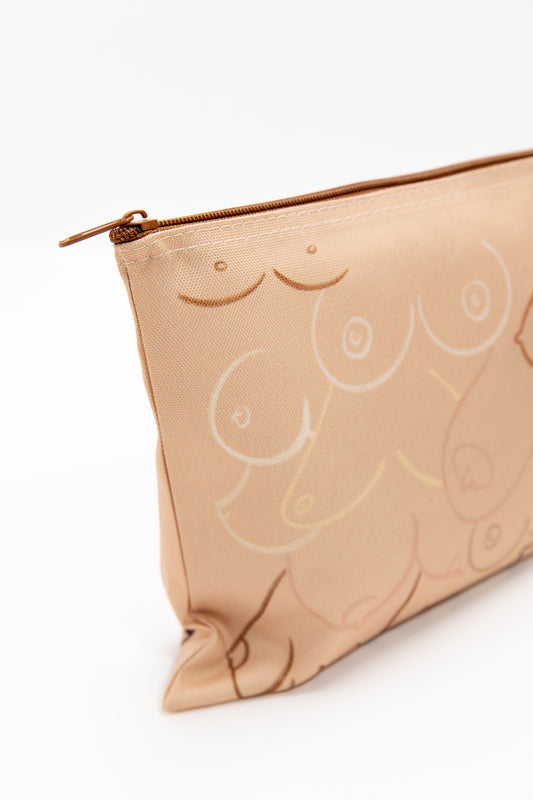
In the early days of motherhood, pumping during the middle of the night may be the last thing you want to do - you're tired! But whether you're an exclusive pumper or supplementing with bottle feeding, nighttime pumping is crucial for maintaining your milk supply early on. In this post, we'll cover everything you need to know about pumping at night, including why it's necessary, the best way to do it, and when you can finally drop those middle of the night pumping sessions.
Why You Need to Pump Throughout the Night
In the first few weeks postpartum, your body is still figuring out how much milk to produce to satisfy your newborn baby. That is why it is important to express milk every 2-3 hours by pumping or nursing, even in the middle of the night.
Understanding Milk Production in Those Early Days
Throughout your pregnancy, your placenta produces high levels of progesterone, which keeps the hormone prolactin suppressed. Prolactin is the hormone responsible for enough milk production. Once your placenta was delivered, your prolactin levels started rising, signaling your body to begin full milk production.
Aren't our bodies incredible?!
For those first 8-12 weeks, prolactin remains the driving force behind your milk supply. Your body will take some time to learn how to properly satisfy your baby's demand (or if you are exclusively pumping, to adjust to the pumping schedule you determine), so you may feel engorged and even notice an elevated supply during this time. It is critical that you remove milk frequently and efficiently, either by feeding on demand, or by pumping 8-12 times per day, to establish a solid milk supply. Imagine prolactin is driving the bus and supply and demand are riding shotgun.
Tips for Pumping at Night
While the night-pumping phase will eventually come to an end, having the right tools while you're in the trenches can make all the difference.
Choose the Right Pump
An electric breast pump with a strong and effective motor is your best friend for nighttime pumping sessions. Check out this blog How to Choose Your Breast Pump to help decide which pump is best for you. While you will often see the term Hospital Grade pump, this is often used to simply sell the pump. There are no qualifications met when referencing this term, it's better to crowdsource. While wearable cups and pumps may be more convenient at certain times during the day, the nighttime hours are a good time to assure you are using the pump that most effectively empties your breasts.

Need reviews on different pumps?
I'm your girl! Follow me on Instagram @bemybreastfriend for my thoughts on various pumps on the market.
Keep Track of Pumping Time
When you're burning the midnight oil, it's easy to lose track of time. Falling asleep while pumping can lead to over-pumping, which can have some painful results. Thankfully, many pumps come with an automatic shut-off feature after 30-40 minutes. If yours does not have one, and you have a tendency to fall asleep while pumping, make sure to set an alarm for yourself.
Equally as important, ensure your position supports proper placement of the nipple inside of your flange or wearable cups in order to avoid nipple trauma!
Feed Baby While Pumping
If your baby is waking up multiple times throughout the night to eat, and you're also pumping, you're looking at a lot of awake time. To maximize your sleep, consider these options:
-
Ask for Help: During the night, focus on pumping while your partner handles feedings. Help with even one feeding session can be a game changer. Perhaps you even sleep in a separate room when you know your significant other will be taking on feedings in order to maximize your sleep.
- Feed While Pumping: It is possible to pump and feed a bottle at the same time. It may be a little awkward at first, but you'll figure out which positions work best for you and your baby. You might try sitting crisscross on the floor while your baby lays across your lap or propped up in a sitting position on the floor in front of you. It takes some practice, but it's worth it for the extra sleep!
Helpful Tools
There are plenty of items for purchase that will make your nighttime pumping experience a more positive one. Consider keeping all of these items in a little "pumping station" by your bed!
-
Night Light: A soft night light like this egg lamp is one of my favorite must-haves for new moms. It provides just the right amount of light while also helping your baby understand that it's still nighttime.
-
Breast Milk Chiller: The Ceres Chiller is a fantastic compact milk storage system that will keep your breast milk cool for the entire night. Say goodbye to making trips to the kitchen at 3am to refrigerate your milk! Use affiliate code Bemybreastfriend15 for 15% off!
-
Mini Fridge: Did you know that you can store pump parts in the fridge between sessions instead of washing them? Check out my Instagram post about The Fridge Hack for more details!
-
Pump Storage: Unless your fridge is specifically devoted to pump parts and is sanitized frequently, you should store your used pump parts in a storage container or bag. To avoid waste when storing your pump parts in your fridge during the night, check out these Sarah Wells Pumparoo bags and use affiliate code MYBREASTFRIEND15 for a discount!
- Comfy, Cute Pajamas: Because why not?! Look good, feel good!
Dropping the Night Pumps
Everything you need to know about pumping at night also includes knowing when and how you can stop doing just that! You've been pumping every 2-3 hours, even through the night, to keep up your milk supply. But as your baby starts to sleep for longer stretches, you might wonder when your pumping schedule can allow you to get some more zzz's too!
How Your Body Adapts After the First 8-12 Weeks
Once you hit the 8-12 week mark, your body begins to regulate milk production. Prolactin and supply and demand switch seats, with supply and demand now taking the more dominant role in milk production. While prolactin is still needed, it is not enough to maintain your supply on its own. Rather, your body learns to match the demand of your baby.
For pumping moms, this may mean that your pumping schedule can be adjusted to better fit your baby's lengthening sleep stretches. In other words, you could drop one of your middle of the night pumping sessions without greatly impacting your supply or becoming overly engorged.
How do I Know if I Can Drop a Night Pump?
If your supply has regulated, it may be time to drop one of those middle of the night pump sessions. Not sure if your milk supply has regulated? Here are some things to look for:
-
8-12 Weeks Postpartum: If you are past 8 weeks postpartum, your body may be ready to drop that night pump!
-
Less Engorgement/Softer Breasts: Your breasts may no longer feel overly engorged throughout the day, which indicates that your body is producing just the right amount of milk. Your breasts should feel soft and comfortable.
-
Less Leaking: If you are leaking less frequently, that's another great sign that your milk supply has been regulated.
- Decrease in Supply: You may notice a slight dip in your supply, but if your volume remains fairly consistent and your baby is satisfied, that is a good sign.
Which Night Pump Session Should I Drop First?
If you are pumping every 2-3 hours, even through the night, you may wonder which session would be best to drop. Now that your supply has regulated, you can be a little creative in the ways you decide to adjust your pumping schedule.
Let's say your pumping schedule for the first 8-12 weeks has been every three hours as follows: 6am, 9am, 12pm, 3pm, 6pm, 9pm, 12am, 3am (NOTE: that this is just an example!). Here are some options you might decide to try:
-
Option 1: Try dropping the 3am session so that you are able to get a 6 hour sleep stretch from midnight to 6am (assuming your baby is sleeping during that entire stretch or your significant other is willing to do bottle feedings during that time). With this option, you are now pumping 7 times a day instead of 8.
-
Option 2: Adjust your schedule so that you pump a bit more frequently at one or more points during the day, thus creating an even longer stretch between pumps at night. For example, you may follow a schedule like this: 6am, 8am, 11am, 2pm, 5pm, 8pm, 11pm. Like option 1, with this option, you are still pumping 7 times a day instead of 8, but you get a 7 hour stretch from 11pm to 6am.
- Option 3: Instead of completely "dropping" a pumping session, adjust your schedule to include a stretch of 4-5 hours at nighttime. For example, pump at 4am instead of 3am, but keep your other pumping routine times the same. This is a great way to gradually create longer stretches between sessions if you are prone to engorgement or clogged ducts!
Don't be afraid to get creative with your pump schedule once you hit the 8-12 week mark, but be sure that you are cautious of signs that it may have been to early make adjustments:
- Steep decrease in milk supply
- Overly full, painful breasts
- Frequent clogged milk ducts or mastitis
Being aware of these signs can help you avoid accidentally reducing your milk supply significantly before it's fully established.
Final Thoughts
If you are in the throws of exclusive pumping and longing for longer stretches of sleep, you are not alone. This post may have everything you need to know about pumping at night, but it doesn't mean it will always be easy. Pumping at night can be exhausting, especially in the early days. The good news is that it gets better with time, and with the right tools and a bit of planning, you'll soon be able to get those longer sleep stretches you've been dreaming of!






